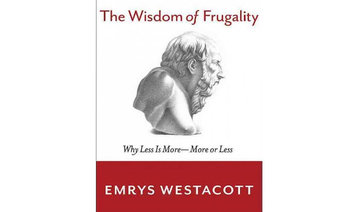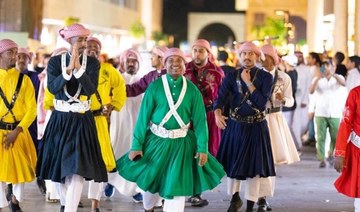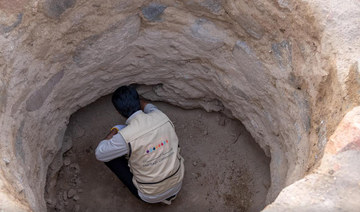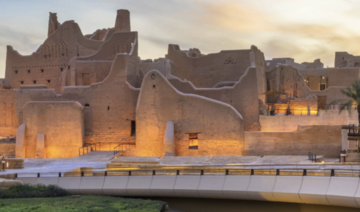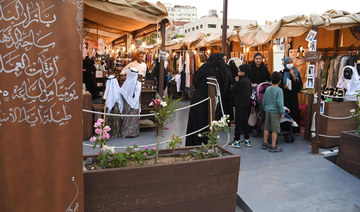How can you become one of the youngest women working as a deputy chief of staff for the president of the United States? How can you make it to the White House when you have no connections, and you have not even attended an Ivy League university?
In this fun-loving book, “Who Thought This Was a Good Idea,” a White House Official reveals a side of politics we never see.
She has written a sincere and gripping memoir of her years in Washington, which is also the inspiring story of someone very ordinary who managed to live an extraordinary life.
Mastromonaco also wrote this book to encourage women to work in the government because most of the people who work in politics are men and most political memoirs written are in turn by men.
Mastromonaco was an ordinary girl living an ordinary life. “I grew up in a town where you didn’t know who had money and who didn’t. The wealthiest families were probably the Equine Veterinarians, and they drove beat-up Suburbans and Wagoneers,” Alyssa wrote.
While studying for a French major, she became interested in politics and decided to apply for a summer internship with Bernie Sanders. She landed the internship and it gave her the first taste of politics and a valuable experience. Mastromonaco was quick to notice that Sanders met with constituents more than any other politician she’d known. He also showed her how to see the people whose problems he could immediately impact and solve. Sanders was also helped by staff who genuinely shared his desire and will to help the constituents.
This says Alyssa “is not necessarily true of other senators; many politicians have staff made up of climbers, who move from one senator to another to get up the ladder, with the ultimate goal of becoming a legislative director or chief of staff.” 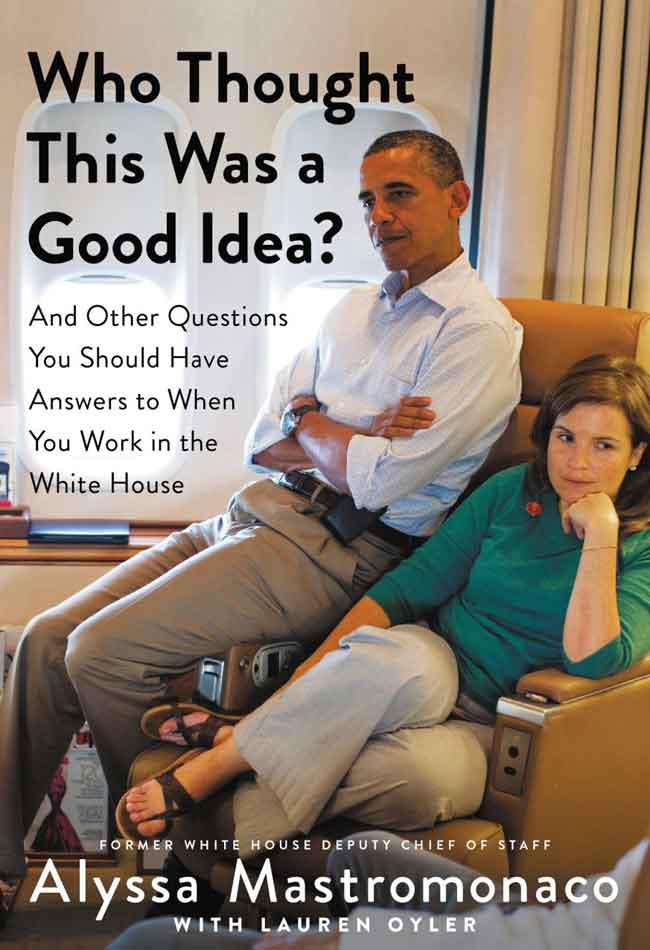
Although she didn’t get to interact very much with Bernie, she knew now that she wanted to work in the government. After her graduation, she did a brief stint at Merrill Lynch and in the spring of 2000, she was finally offered the position of assistant to the press department and scheduler thanks to a convincing and passionate plea for a job addressed to John Kerry’s intern coordinator. She worked on and off for four years and, connections are always useful. Robert Gibbs, who had quit the Kerry campaign to work on Obama’s US Senate race, came at the right time with a job proposal, as director of scheduling. Alyssa thought Obama, who was practically unknown at the time, would be thrilled that someone with experience, charm and talent would want to work for him. Mastromonaco was wrong: “Barack Obama is tougher than that. He cared less about my credentials and more about the fact that I wasn’t from Illinois,” she said. After some persuading, Obama offered her the job.
Four years after she started working for Obama, and just days before the general election, Obama was due to appear in an event in Chester, Pennsylvania. The weather forecast was bleak and Republican Sen. John McCain had canceled all his events. Obama is not fond of the cold but according to Mastromonaco, “how better to show contrast with an old and tired Senator McCain than with a spry and virile Barack Obama, so dedicated to the American public that he would endure a snowstorm to tell them about his vision for the country?”
So, the Chester event was kept on the schedule. The weather as predicted was awful. The meeting was televised, and it showed a charismatic and courageous Obama with his face smacked by sleet. At the end of his speech, Obama made a phone call: “Alyssa, it’s Obama. The event looked AWESOME! You heard John McCain canceled all of his events, right? He looked like a total old man.
“Alyssa, where are you right now?”
“My desk”
“Must be nice.”
A week later, Obama had won the general elections, carrying the District of Columbia, and 28 states, including Pennsylvania. Damon Winter, a photographer from the New York Times, received a Pulitzer Prize for his coverage of the presidential campaign and the winning work included a photo of the Chester event.
“I first walked through the gates of the White House about a month before Obama took office and I would officially start working there. I was going to be the assistant to the president for scheduling and advance... Assistant to the president is the most coveted position in the White House; there are only about 20 to 25 of them at any one time. I was one of the youngest women to ever hold that title, if not the youngest,” wrote Mastromonaco.
This behind-the-scenes memoir shows us that high-level meetings are not always as organized as they should be. A UN Climate Change Conference was due to take place in Copenhagen and it was not clear whether the negotiations would be ready for heads of state to participate. The decision to attend was made just a week before the convention. It was a tight schedule with an early morning arrival in Copenhagen and a departure immediately after the end of the conference.
President Obama had requested to meet Chinese Premier Wen as well as Brazilian president Lula da Silva, the Indian prime minister Manmohan Singh, and South African President Jacob Zuma. By the afternoon, nobody had responded and to make matters worse, nobody knew where the delegations were except for the Indian delegation, which had apparently already left for the airport. At that point, Hillary Clinton who was heading the negotiations wanted to know if the Indian delegation had really left. Soon after, the news broke out that the Indians and all the missing delegations were attending a secret meeting organized by Chinese Premier Wen. President Obama and Secretary Clinton walked immediately to the conference room. Obama passed in front of shocked Chinese officials and entered the room, exclaiming “Premier Wen! Are you ready for me?” Secretary Clinton recounts in her memoir that she “ducked under” the Chinese guards to make it inside. All the people attending were flabbergasted, but Obama finally held his meeting and even clinched an agreement after an hour and a half. In the meantime, a snowstorm was threatening Washington; if there was too much delay, Andrews Air Force Base would close down.
“Even though pretty much everyone disagreed with me, I made them wait. The situation was tense and the stakes were so high that I knew we had to give the president as much time as he needed… we took off out of Copenhagen two and a half minutes before we would have been held up there because of weather. Persistence will get you far and leaders have to champion the push,” explained Mastromonaco.
Traveling with the president is not what we imagine. It certainly is not a holiday.
The schedule is so hectic that it is not even clear when one will eat.
Sometimes, a whole day goes by without food. In 2012, there was so much traveling that meetings would be held from AF1 or by phone in the motorcade.
When Mastromonaco was promoted to deputy chief in January 2011, her personal life changed. She was at work at 6:45 in the morning and back home at 8 p.m.. She stopped going out and making plans because something could come up at any moment of any day. When Mastromonaco was not in the office, she was at home waiting beside two secure phones and a secure computer.
For almost a decade Mastromonaco, who is now president of global communications strategy and talent at A+E Networks, worked hard. Most people leave the White House after three years because it drains you.
“Working in the White House is incredible, but it is also completely, totally exhausting and exhausting isn’t even descriptive enough,” wrote Mastromonaco.
“I loved being part of an administration that I thought was making the country better…Plus when I traveled for work, I took Air Force One…and instead of wasting time at boring conference centers, I was doing things like eating goat in the courtyard of Hamid Karzai’s palace.”
But there comes a time when even beautiful memories cannot prevent even the most dedicated aides from becoming irritable and angry. The stress was taking its toll. For Alyssa Mastromonaco, who was listed in 2011 as amog Washington’s most powerful, least famous people, it was time to leave.
On her last day at the White House, she gave in her security badge, promised not to talk about anything classified, packed all her boxes in her car including a painting of a landscape in Iowa, a present from Obama, and drove away.
Mastromonaco had finally quit a high-power job but could she ever forget the feeling and satisfaction it gave her? “I can do a lot, and I know that I have to. Besides, if I’m being completely, totally honest, there are a couple of (female) politicians out there whose work I really, really believe in. If any of these women ever decided to make a big run, and if they thought I could serve them well, I would have a very hard time saying no.”
—
Email: [email protected]
Book Review: The rare art of sincerity in Washington politics
Book Review: The rare art of sincerity in Washington politics
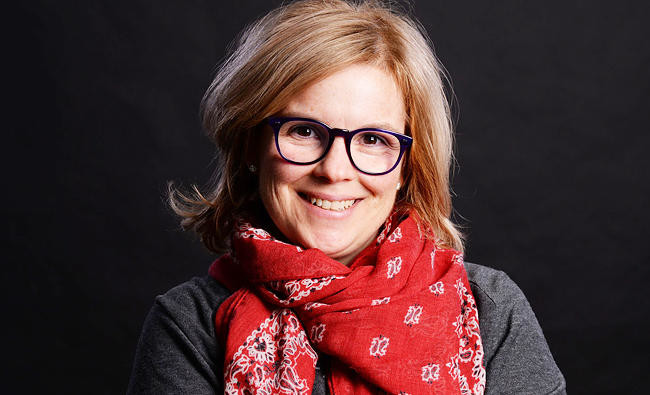
Saudi Music Commission hosts open meeting on preserving national musical heritage
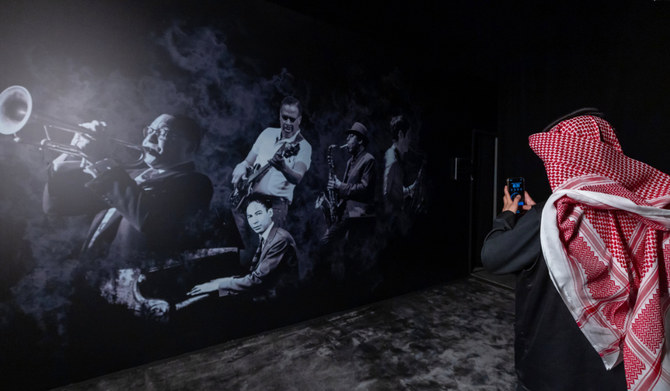
- The meeting highlighted the achievements of the Saudi Music Memory initiative, which secured rights for over 5,000 works, documented 305 musical notations, and produced two musical notation books
RIYADH: The Music Commission hosted an open meeting on the Saudi Music Memory initiative, engaging with music enthusiasts and industry professionals, the Saudi Press Agency reported on Tuesday.
The goal was to involve them in preserving the Kingdom’s musical heritage, as part of a series of open meetings designed to keep the musical community informed and encourage their participation in documenting and preserving Saudi music.
The virtual meeting outlined the initiative’s focus on documenting music and lyrics composed by Saudi artists through the mid-1980s, aiming to preserve and archive these works and the evolution of the Saudi music scene.
The meeting highlighted the achievements of the Saudi Music Memory initiative, which secured rights for over 5,000 works, documented 305 musical notations, and produced two musical notation books. The first book, titled “From the Memory of National Songs,” was released to coincide with this year’s Founding Day. The second book, “From the Memory of Ramadan Songs,” is completed and set to be published before Ramadan 2025.
The meeting featured interviews with renowned artists who experienced the early days of Saudi music, like Mohammed Abdu, Abadi Al-Johar, and Jamil Mahmoud, who shared stories about the origins of Saudi music and the role of its pioneers.
The meeting outlined the stages of the initiative, beginning with securing the rights to use classical musical and lyrical works, which has been completed. The second stage, transcribing musical works, is underway. Next, the commission plans to create documentary content and reproduce and distribute significant musical works, expected to be completed in the upcoming year. Once these stages are finished, the final step will be building an integrated platform.
The commission adhered to a scientific methodology, ensuring honesty and neutrality in all outputs of the initiative. It eliminated community and private artistic biases, aligned with the Saudi Cultural Memory Center, followed the guidelines in the documentation and digital archiving manual issued by the Ministry of Culture, and conducted a comprehensive inventory of all relevant materials and information.
The commission launched the Saudi Music Memory initiative to document the history of Saudi art, aiming to create a reliable reference, highlight its regional influence, offer academically documented research for musicians, researchers, and interested parties, and showcase high-value musical works that have not received due media attention, the SPA reported.
Macklemore shares teaser for new song in support of Gazans

DUBAI: American rapper Macklemore is set to release a new song this week in support of Palestine.
Titled “Hind’s Hall,” the track honors Hind Rajab, the 6-year-old Palestinian girl who was killed by Israeli soldiers in Gaza while waiting to be rescued.
Drawing its inspiration from the global student protests, the singer released a teaser of the track on his Instagram feed and said that all proceeds from its sale would be donated to UNRWA.
“The people, they won’t leave / What is threatening about divesting and wanting peace? / The problem isn’t the protests, it’s what they’re protesting / It goes against what our country is funding / Block the barricade until Palestine is free,” he sings.
“What you willing to risk? / What you willing to give? / What if you were in Gaza? / What if those were your kids? You’d want the world to stand up / And the students finally did.”
The full song has yet to be released on streaming platforms.
Saudi Heritage Commission event celebrates ancient Rakah
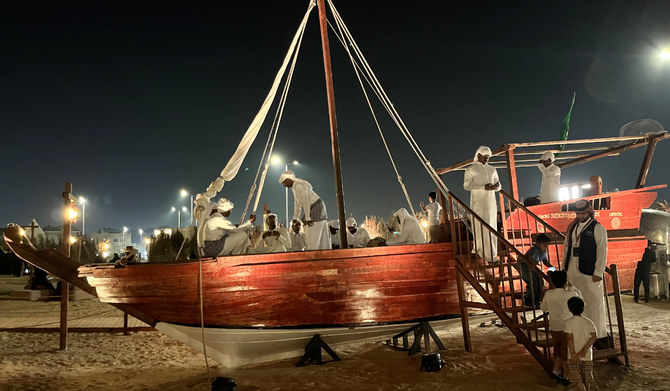
- “We want our customers to enter our space, either in our booth at the event this week or our studio location, and in just a short time be able to produce something customized to take home, she told Arab News
DAMMAM: The Heritage Commission is holding an event to celebrate ancient Rakah, with historical reenactments, guided tours, archaeological experts and handicrafts.
Once a major trading spot, some 1,500 years ago, the area takes its name from an indigenous tree species that once flourished there. The sandy environment was also once under the sea and shells can be found still glued to the rocks.
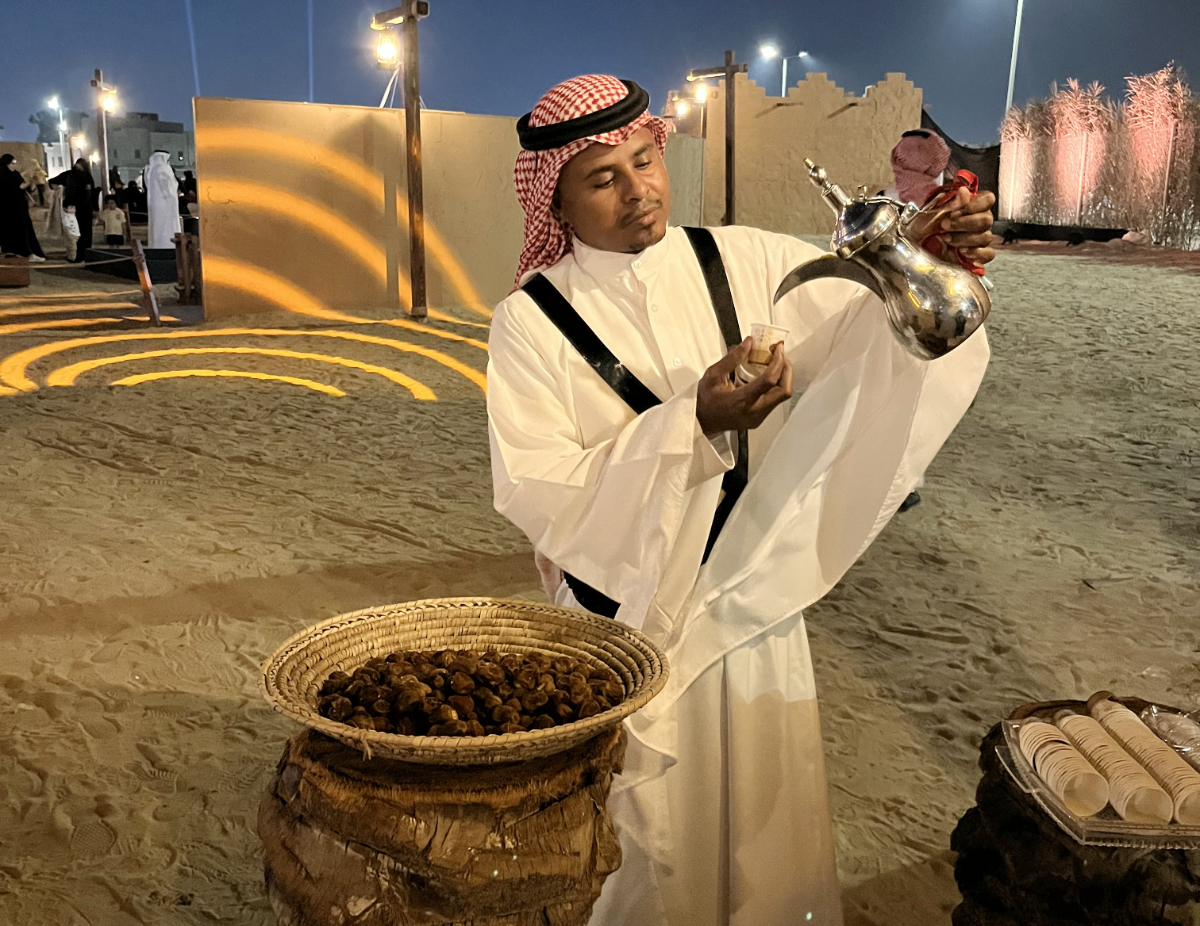
Many of the guides are female archaeology graduates from Imam Abdulrahman Bin Faisal University, formerly known as the University of Dammam.
Wala Al-Nafaiai, who co-founded Dam Studio, a local business that specializes in handmade goods made of cow and camel hide, said she was looking forward to showing off her products to visitors.
FASTFACTS
● Once a major trading spot, some 1,500 years ago, the Rakah area in Dammam takes its name from an indigenous tree species that once flourished there.
● The sandy environment was also once under the sea and shells can be found still glued to the rocks.
“We want our customers to enter our space, either in our booth at the event this week or our studio location, and in just a short time be able to produce something customized to take home, she told Arab News.

“Instead of going to a restaurant, we want you to spend the time to have an experience, produce something practical and learn skills you can utilize later.”
Al-Nafaiai said she was delighted with how many people had taken part in the workshops she provided at her booth.
It seems many (people) enjoy customizing something that they feel connected to once they make it with their own hands.
Wala Al-Nafaiai, Dam Studio co-founder
“It was so crowded … I was surprised that there were more adults than children who wanted to join in, although the craft was very simple,” she said.
“It seems many (people) enjoy customizing something that they feel connected to once they make it with their own hands. And that is our goal and the goal of the Heritage Commission who invited us to join this successful event.”

Visitors were also able to learn about the importance of dates to the community in ancient times and how local people would make and trade date syrup with visiting merchants.
Organized in cooperation with the Sharqiya Development Authority, the festival ends on Tuesday. For more information, visit heritage.moc.gov.sa or @mocheritage.
Riyadh forum highlights importance of cultural identity and Arab heritage
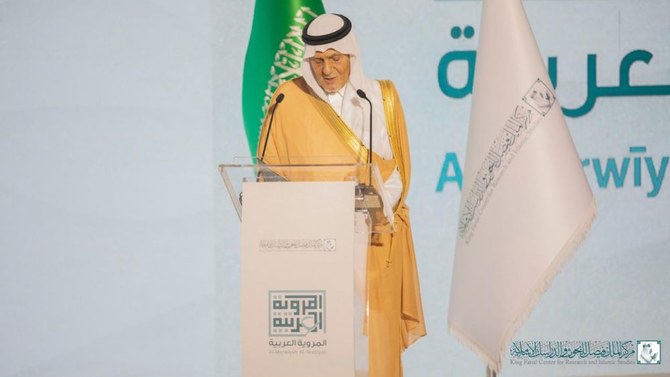
- Scholars, officials, experts explore and celebrate Arabian Peninsula
- Katakura Kunio said that both Japanese and Islamic cultures had historic roots in promoting peace
RIYADH: The Al-Marwiyah Al-Arabiyah Conference, called “Desert Culture,” concluded on Monday in Riyadh. The two-day event brought together a diverse group of scholars, officials, and experts to explore and celebrate the rich cultural heritage of the Arabian Peninsula.
Prince Turki Al-Faisal, the chairman of the King Faisal Center for Research and Islamic Studies, said that nomadism was central to Arab culture, emphasizing its roots in values over materialism. He noted that Arabs were natural storytellers, adept at turning chaos into clarity.
Katakura Kunio, president of the Motoko Katakura Foundation for Desert Culture in Japan, delivered a speech in memory of his late wife, anthropologist Motoko Katakura, which highlighted her research in Saudi Arabia.
Kunio said: “Motoko’s enduring passion for comfort inspired our foundation to establish the Comfort Prize, aimed at supporting both Japanese and international researchers and artists. This award honors individuals who dedicate their lives to enriching desert culture.
“In the current climate of positive change within Saudi Arabia, including the increased societal participation of women and the focus on tourism development, it is natural to re-evaluate the traditional value of comfort. Perhaps, in a world increasingly driven by hyper-capitalism, comfort can offer a remedy for the global population yearning for a slower pace.”
Kunio said that both Japanese and Islamic cultures had historic roots in promoting peace. He noted that Prince Shotoku of Japan endorsed “respect for peace” in his 17-Article Constitution, while the Prophet Muhammad established the Madinah Charter, which also emphasized peace and tolerance. These parallels suggested a common ground for fostering cross-cultural understanding, he added.
Abdullah Hamidaddin, assistant secretary-general for scientific affairs at the KFCRIS, described Al–Marwiyah Al-Arabiyah as a research initiative which aimed to address confusion about Arab civilization. It sought to combat attempts to undermine and marginalize Arab culture.
Hamidaddin said that the project used scientific methods to study Arab narratives and the origin of language in the Arabian Peninsula, while promoting dialogues, field studies, and critical analyses in various fields, including history, archaeology, sociology, philosophy, literature, and art.
The conference aimed to highlight the civilizational and cultural significance of the Arabian Peninsula, while seeking to strengthen the sense of Arab identity for future generations. It also promoted cultural exchange between the Arab world and neighboring regions.
A lecture titled “Gifts of God (Camels),” by Sulaiman Al-Theeb, cultural adviser at the center, was presented during the conference.
He spoke of the Arabian Peninsula’s deep connection with camels through three key concepts: rock and mural art; archaeological finds, like daily tools; and references to camels in ancient Arabic inscriptions, especially Thamudic writings.
Al-Theeb highlighted the significant status of camels in the region, which has earned them the moniker “the ship of the desert.”
Mohammed Al-Rowaily, a member of the Cultural Council at the Abdulrahman Al-Sudairy Cultural Center, said that the Arabic narrative played a crucial role in sharing ideas with others. He noted that Arabic storytelling enhanced cross-cultural understanding by conveying elements from history, oral literature, civilization, arts, and other creative works.
Hajar Al-Shammari, a linguistic researcher in Saudi history, said that the event boosted cultural engagement by fostering dialogue and cultural exchange among academics. Through the sharing of ideas it helped to establish a foundation for field studies and critical analyses focused on Arab perceptions and identity.
Al-Shammari added that Arabic storytelling played a significant role in promoting social cohesion, fulfilling the search for roots, and reinforcing values. This was especially important in the context of cultural identity and Arab heritage.
Moroccan photographer Hassan Hajjaj captures the culture of AlUla

- The acclaimed Moroccan photographer discusses his recent show in Saudi Arabia
DUBAI: Early in February this year, Moroccan contemporary artist and photographer Hassan Hajjaj was given a reminder of just how high his star has risen. Within a few days of each other, Hajjaj had shows opening in the US, Morocco, and — as part of AlUla Arts Festival — Saudi Arabia.
Hajjaj’s playful portraiture, which incorporates vivid color, funky clothing (almost all of which he designs himself), geometric patterns, and — often — vintage brands from the MENA region, has made him internationally popular, and his instantly recognizable style has established him as one of the world’s leading photographers.
His show in AlUla consisted of images that he shot in the ancient oasis town in February 2023. That visit was initially supposed to involve shoots with around 20 local people. It’s the kind of thing he’s done a few times before, including in Oman and Abu Dhabi. “It’s always a good opportunity to get to know the culture and the people,” Hajjaj tells Arab News.
But, as he says himself, he arrived in AlUla as “an outsider,” so needed a team on the ground to persuade locals to come and sit (or stand, in most cases) for him.
“It was a bit tough, in the beginning, for them to find people,” Hajjaj explains. “But because it was during a period when lots of art things were happening in AlUla, there were lots of people coming from outside AlUla as well. So we opened it up. I basically said, ‘Just come.’
“In the end lots of people turned up, not just locals — people from Riyadh, Jeddah, and people (from overseas) too. I think I shot around 100 people over a few days. So it was a great opportunity,” he continues. “To get to shoot that many people over three days — organizing something like that for myself might take a year. So, as long as I have the energy, when I get these opportunities — you know, I’m in AlUla with this eclectic bunch of people — I’d rather go and grind it, really work hard, and have that moment.”
A Hassan Hajjaj shoot isn’t your regular portrait shoot, of course. “It’s almost like a performance,” he says. “There’s music, people dress up, it’s like a day out for them, taking them out of themselves for a few hours.”
He followed the same modus operandi in AlUla. “We got an ambience going. It was fun, there was music… I shot in this beautiful old school that was one of the first girls’ schools in Saudi Arabia, from the Sixties. Upstairs was like a museum — everything was like a standstill from the Seventies and Eighties; even the blackboards had the chalk and the writing from that time,” he says.

A crucial part of Hajjaj’s practice is to ensure that his subjects are at ease and feel some connection with him (“comfortable” is a word he uses several times when talking about his shoots). While all his portraits bear his clearly defined style, it’s important to him that they should also show something unique to the people in them.
“It’s that old thing about capturing the spirit of the person in that split second, you know? I’m trying to get their personality and body language in the image,” he says. “Quite often I’m shooting in the street, outdoors, so (the subjects) can start looking at other people, thinking, ‘Are they looking at me?’ So I usually say, ‘Listen. This is a stage I’m building for you. I’m dressing you up, and we’re going to have fun.’ Then I just try and find that personality that can come out and make the image stronger. With some people, though, saying almost nothing can be better — just getting on with it. I try to kind of go invisible so it’s the camera, not the person, that’s doing the work. The best pictures come out when there’s some kind of comfortable moment between me and the person and the camera.”
It’s the way he’s worked since the beginning — a process that developed organically, as most of his early portraits were of “friends or friends of friends.”

“There’s a comfort in that because you have a relationship with them. It made it easy,” he says. “And that taught me about how important it is to build trust with people to get into that comfortable zone. But as time went on, obviously, people could see the stuff in the press or on social media, so then people started, like, asking to be shot in that manner; maybe they’ve studied the poses of certain people and stuff like that, so they come ready to do some pose they’ve seen in my pictures. That’s quite funny.”
The work that was on display over the past two months in Hajjaj’s “AlUla 1445” is a perfect example of what he tries to achieve with his shoots. The images are vibrant, playful, and soulful, and the subjects run from a local goatherder through the AlUla football team to bona fide superstars: the US singer-songwriter Alicia Keys and her husband Swizz Beatz.
Hajjaj says he has a number of favorites “for different reasons,” including the goatherder.

“He brought in two goats and it became quite abstract when you put all of them together. I was playing with that notion of the person; you could see that’s his life and even the goats look happy,” he explains. “I wanted to make sure they had that shine in the image as well. I got some great shots of him.”
The Alicia Keys and Swizz Beatz shoot has been a long time in the making. Hajjaj first met Swizz Beatz a decade ago, and they have been in touch intermittently ever since. The idea of a shoot with Keys first came up about five years ago, but logistics had always got in the way. But since they were playing a concert in AlUla at the same time as Hajjaj was there, it finally happened, on Hajjaj’s last day, with perhaps an hour left before the light faded.
I ask Hajjaj if his approach to shooting celebrities differs from his shots of “ordinary” people.

“There’s probably not that much difference,” he says. “They’re coming into my world, so, again, it’s just making sure they’re comfortable with you and you’re comfortable with them; not looking at them (as celebrities). The only thing is you have to imagine they’ve been shot thousands of times — by top photographers, too — so they’re going to have their ways. So I just have to lock in with them and find that comfortable space between the sitter and me.”
And then there’s Ghadi Al-Sharif.
“It’s a beautiful picture. She’s got this smile, with her hand over her face. For me, that one really presents the light and the energy of AlUla,” Hajjaj says. “It captures the new generation.”




